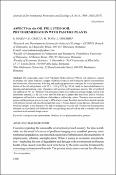Options
Aspects in situ oil polluted soil phytoremediation with pasture plants
Date issued
2017
Abstract
Oil compounds, name Total Petroleum Hydrocarbons (TPH) in soil chemistry, content in polluted soil cause dramatic changes of physicochemical and biological topsoil characteristics and destruction of ecosystems. Selecting and applying appropriate strategies for in situ phytoremediation of the oil soil polluted with 95.5 ± 25.0 g TPH kg–1 D.M., leads to their rehabilitation by planting and maintaining crops of pastures with grasses and leguminous species. The oil polluted soil addition of 50 t ha–1 fertilizer with nitrogen content, like stabilized sewage sludge, mixed with adsorbents material, i.e. fly ash waste derived from power plants that use fossil fuel or volcanic indigenous tuff has led to the installation of abundance and healthy culture. The areas were covered by grasses and leguminous species were up to 90% of sown areas. Resulting harvest from treated variants
with fertilizer mixed with adsorbents, material were 2–3 times higher versus harvests obtained from fertilized variants in the absence of fly ash on indigenous volcanic tuff. The harvest characteristics obtained on oil-polluted soil fertilized with sewage sludge mixed with fly ash or volcanic tuff were correlated with national forage norms.
with fertilizer mixed with adsorbents, material were 2–3 times higher versus harvests obtained from fertilized variants in the absence of fly ash on indigenous volcanic tuff. The harvest characteristics obtained on oil-polluted soil fertilized with sewage sludge mixed with fly ash or volcanic tuff were correlated with national forage norms.
Files
Loading...
Name
Masu JEPE 2017.pdf
Description
Article
Size
355.37 KB
Format
Adobe PDF
Checksum
(MD5):7714a628df000503930fa0e70e73f4ec